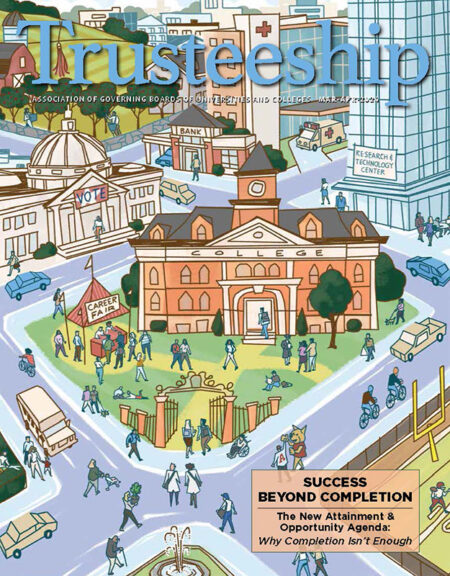
The liberal arts have served as a broad-based approach to higher education, emphasizing exploration and critical thought. However, in the face of the “demographic cliff” and public perception about an erosion of the value of higher education, the four-year liberal arts experience has been declining in popularity with Gen Z students and their parents. As the readers of Trusteeship are fully aware, relevance and return-on-investment are essential to counter this trend.
In our rural industrial region, advanced manufacturing industries are resurging and those of us on the board of Allegheny College, founded in 1815 in Meadville, Pa., believe that the benefits of a liberal arts education can serve this new industry well. We were disappointed to learn however that we had been viewed by business leaders as not able to meet their needs for workforce development. We realized that we weren’t doing a good job connecting the dots for these leaders (along with some prospective students’ parents) about the value we bring. We had to repair that disconnect.
Framing the Future
About a year ago, the Allegheny College board came together with our president to establish a pathway for the College’s future. Creating an economic development strategy emerged from a board session, where we were asked to come up with guardrails to define the College’s future. We reviewed 15 different topics—everything from core values to college size to online learning, and athletics to non-degree programs. Where was our comfort zone? What were our limits? Where could we imagine pushing the boundaries?
We considered enrollment potential. How could we retain our liberal arts core but evolve to be relevant into the future? What would make us stand out? What could help translate the value of a liberal arts education?
We agreed we must come up with a viable plan of action to graduate a vibrant, highly educated workforce with transferable skills that help grow a strong economy. If we could become a major driver of that, then everyone would benefit.
If You Build It, They Will Come
We knew as a board that Allegheny College could help regional industry with upskilling their workforce, offset research and development expenses, and add expertise and flexibility. We also knew that we had to show (not tell) regional business leaders how we could do this.
The first major outcome of our commitment to regional economic development is the Allegheny Lab for Innovation & Creativity (ALIC), launched as a campus-wide multi-disciplinary educational resource in 2019, and expanded to connect to industry at an off-campus site in 2022.1 This groundbreaking program is developing skills that today’s employers value while redefining how students develop the proficiency and mindset necessary to excel in emerging technologies. ALIC is actively preparing students for today’s creative high-tech jobs as well as workforce applications that haven’t even been imagined yet. ALIC empowers students and faculty across disciplines to explore, design, and build, prototyping products, programming robotics, and developing software in virtual environments, housed by a facility equipped with an array of digital equipment.
Through ALIC we launched cooperative programs with more than 20 business and industry partners in the Meadville region and Pittsburgh to train students, hire interns, and identify employees who are already up to speed on emerging technologies. We launched workshops that respond to regional needs by helping employers upskill their current workforce. ALIC is a venue for our new microcredentials that leverage our culture of multidisciplinary learning and demonstrate student skills and competencies gained through classes and internships as part of students’ liberal arts education.
As a result, Allegheny College is building a strong college-to-industry pipeline that is attracting quality students and helping to keep them in the community with good jobs. This is generating greater positive visibility for the College and new revenue opportunities.
Lessons Learned
Some of the lessons we learned post-planning and in the first years of implementation can easily be adapted by boards of colleges facing similar challenges. Broadly speaking, foster a culture of collaboration, open communication, and targeted investment among the board, the administration, and the campus community; this was important for us not only to identify problems but to empower solutions. More specifically, leverage your region—turn the tables by asking companies in your area what they need rather than trying to sell what you have. Lastly, dig down and be true to your institution’s mission and core values while not being afraid to push the boundaries for how liberal arts education can serve workforce development in emerging technologies.
Boards that are innovation-focused can help the college’s president and administration turn ideas into realities and real-life solutions. Allegheny College is demonstrating that higher education can pivot to bring value to today’s industries and debunk misconceptions surrounding the relevance of a liberal arts education in an ever-changing world.
Steven Levinsky is chair of the Allegheny College Board of Trustees and an alumnus with a bachelor’s degree in political science and economics. A retired senior vice president from Fidelity Investments, he currently is a partner in ConverSage, an innovative digital healthcare solutions company creating AI-driven, conversational, virtual humans to address mental health and wellness. Slevinsky@conversage.com.



